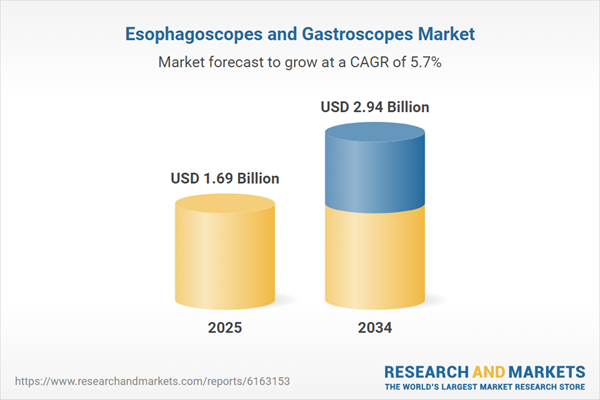Esophagoscopes and Gastroscopes: Introduction
Esophagoscopes and gastroscopes are medical equipment that are used in the minimally invasive surgical procedures, known as esophagoscopy and gastroscopy, respectively. In esophagoscopy a long, narrow, soft tube with a light and camera is inserted into the patient's mouth to examine the inside of the body for certain abnormalities.Gastroscopy is also a procedure which is performed to examine throat, esophagus, and stomach. In this test, a long, soft tube-like device is inserted through mouth to the stomach. With this process, tissue removal can also be performed. This is performed in the cases where widening of food pipe (esophagus) is required and causing pain or difficulties while swallowing food, also to stop bleeding inside stomach or esophagus or to remove growths from inside the stomach.
Esophagoscopes and Gastroscopes Market Analysis
The increasing advancement of technologies in the development of gastroscopes and esophagoscopes in the market is a major driver propelling the market growth. The increased preference of geriatric population about minimally invasive procedures when it comes to the treatment of diseases that cannot be cured without incisions is leading to increased demand for minimally invasive surgical procedures.Additionally, the escalating demand for well-established healthcare infrastructure and advanced equipment is also expected to aid the esophagoscopes and gastroscopes market growth in the coming years. The increasing prevalence of chronic diseases amongst the geriatric population is also a major factor propelling the market growth. The rising prevalence of gastrointestinal diseases, especially among the geriatric population is a major driver propelling the global esophagoscopes and gastroscopes market developmentt.
Esophagoscopes and Gastroscopes Market Segmentations
Esophagoscopes and Gastroscopes Market Report and Forecast 2025-2034 offers a detailed analysis of the market based on the following segments:Market Breakup by Esophagoscopes Type
- Flexible Esophagoscopes
- Rigid Esophagoscopes
- Transnasal Esophagoscope
Market Breakup by Gastroscopes Type
- Transnasal Gastroscopes
- Dual-Channel Gastroscopes
- Standard Gastroscopes
- Therapeutic Gastroscopes
- Others
Market Breakup by Application
- Contraindications
- Gastric Ulcer
- Chronic Gastritis
- Normal Mucosa
- Others
Market Breakup by End User
- Hospitals
- Ambulatory Surgical Centers
- Specialty Clinics
- Diagnostic Centers
- Others
Market Breakup by Region
- North America
- Europe
- Asia Pacific
- Latin America
- Middle East and Africa
Esophagoscopes and Gastroscopes Market Overview
The market is witnessing a significant growth and is expected to grow in coming years as well. The major factors aiding the market growth includes the development of innovative esophagoscopes and gastroscopes in the market. Additionally, the increasing demand for minimally invasive procedures is also among the major drivers propelling the growth of the market. The increased demand for minimally invasive procedures is directly increasing the positive pressure on the manufacturers to develop innovative and flexible endoscopes and esophagoscopes to enhance the overall patient experience. The increasing awareness among people about early diagnosis of chronic diseases such as cancer, ulcers, along with preventive measures is also contributing to the global esophagoscopes and gastroscopes market expansion.The increasing awareness among people about the significance of early detection and regular check-ups for gastrointestinal disorders has directly led the rise of screening programs worldwide contributing to the market growth. Esophagoscopes and gastroscopes play a critical role in these screening initiatives, contributing to the market growth. With the help of esophagoscopes and gastroscopes, minimally invasive procedures have become convenient, such as endoscopic surgeries and interventions that reduce the need for traditional open surgeries. Minimally invasive approaches offer several benefits such as reduced patient discomfort, faster recovery times that are positively influencing the increased demand of these devices.
Esophagoscopes and Gastroscopes Market: Competitor Landscape
The key features of the market report include patent analysis, grants analysis, clinical trials analysis, funding and investment analysis, partnerships, and collaborations analysis by the leading key players. The major companies in the market are as follows:- FUJIFILM Corporation
- B Braun Melsungen AG
- Olympus Corporation.
- Smart Medical Systems
- KARL STORZ
- Medtronic Plc
- HOYA GROUP
- Aohua Endoscopy Co., Ltd.
- CONMED Corporation
- Stryker Corporation
This product will be delivered within 3-5 business days.
Table of Contents
Companies Mentioned
- FUJIFILM Corporation
- B Braun Melsungen AG
- Olympus Corporation.
- Smart Medical Systems
- KARL STORZ
- Medtronic Plc
- HOYA GROUP
- Aohua Endoscopy Co., Ltd.
- CONMED Corporation
- Stryker Corporation
Table Information
| Report Attribute | Details |
|---|---|
| No. of Pages | 350 |
| Published | July 2025 |
| Forecast Period | 2025 - 2034 |
| Estimated Market Value ( USD | $ 1.69 Billion |
| Forecasted Market Value ( USD | $ 2.94 Billion |
| Compound Annual Growth Rate | 5.7% |
| Regions Covered | Global |
| No. of Companies Mentioned | 10 |









